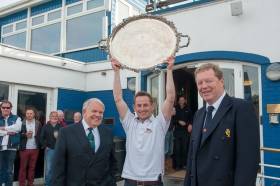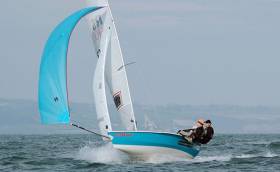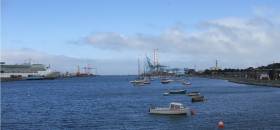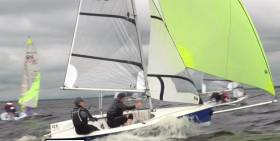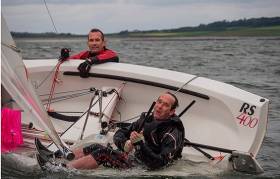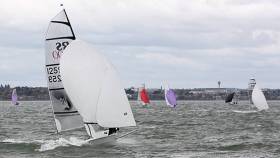Displaying items by tag: RS400
RS400 Sailor Alex Barry is ISA Senior All Ireland Champion 2016
Cork Harbour's own Alex Barry finished on top in the All Ireland Sailing Championships at Royal Cork Yacht Club today but not before an exciting duel for the coveted trophy with Rio Olympic silver medalist Annalise Murphy who finished second overall in the eight boat fleet writes Gail McAllister.
After a frustrating wait in dead calm conditions on day 2 of the ISA All Ireland Sailing Championships sailors were treated to a perfect 20–knots of breeze in the final races. It was thrilling to watch Ireland’s top sailors from each class compete in the latest National 18 dinghies.
Annalise Murphy and crew gave an outstanding performance with 3 bullets in the final 3 races and the final winner was not clear until judges and race officer had done the maths on discards. RS400 sailor from Monkstown Bay Yacht Club came out top with 11 points, with Annalise Murphy only one point behind on 12 and Darragh O’Sullivan, who had dominated the board throughout the afternoon, came in at 3rd with an equal 3 points, because Annalise had 3 bullets to Darragh’s 2. Race Officer Peter Crowley completed a good series with 20 minute races and a fast turnaround between races keeping everyone on their toes.
This weekend’s top sailors came from a broad spectrum of classes RS400, Laser Radial, Laser Full Rig, National 18, ICRA 1, 2 & 3, 1720, IDRA14, RS200, J24, Mermaid, Shannon One Design and Flying Fifteen.
Top eight results are downloadable below.
With only three days to go, excitement is building for the 2016 RS200 & RS400 Irish National Championships in Schull, West Cork. The event, hosted by the Fastnet Marine Outdoor Education Centre will see a fleet of 40 RS400s and 20 RS200s race across two courses under Race Officers David Harte and Alan Crosbie.
Racing will be outside the harbour, south of Long Island, a venue often underutilised but which offers amazing scenery, big waves and clear winds.
RS 'King Of The Liffey' Success At Poolbeg Yacht & Boat Club
Saturday 13th of August saw Poolbeg Yacht & Boat Club hosted its first ever dinghy event as the RS200’s and RS400’s competed for “The King of the Liffey” title which was run as part of the club’s annual Regatta.
With a cruise ship occupying the course racing was postponed for one hour. Competitors gladly took the opportunity to enjoy the hospitality and breakfast rolls laid on by the members and staff at Poolbeg, which more than lived up to its welcoming reputation.
Once the large obstacle had departed, PRO Barry O’Neil and his team wasted no time in getting racing under way. The race officer’s briefing emphasized the aim of the event was to pack as many high quality but fun races into the allowable time and he duly delivered on all fronts. The ten knot Westerly breeze allowed for a perfect windward leeward course to be set. The start line located directly in front of the club house was the ideal spectator vantage point to view the action as boats had a beat towards the East Link toll bridge and barrelled their way back downwind to the leeward gate. There was also plenty of head turning from the passing traffic that paralleled the race course only meters from the water.
Given the tight nature of venue crews had to decide, which side of the river to play upwind. Some beats it appeared to favour going as close as helms dared to the North Wall while other times it paid to tack along the Poolbeg marina and take a chance by dodging into the forest of moorings and club boats on the South side of the river, all of which added to the excitement.
As the day went on the number of spectators grew as the Poolbeg Regatta cruiser racer fleet which include a newly adopted class of six Ruffians returned ashore. The cruisers raced in two classes, with smaller boats competing in a round the cans race on Dublin Bay and the larger yachts enjoying a costal “Three island race”, which took in Dalkey Island, The Muglins and Ireland’s Eye.
After nine races for each of the RS classes and the small matter of another sizeable ship on its way up the river, the fun was over on the water at least. With multiple race winners in each class everyone was left guessing how the final scores would tally up. The competitors had lost count long before the finish.
In RS200’s Neil and Maeve Spain had a very impressive day taking six race wins. Aaron Jones and Rebecca Rock had a very solid event to take second. In third place, with a very consistent set of results, were Triona Hinkson and Helen O’Bernie who showed plenty of potential and will definitely be a team to watch in future RS200 events.
In the RS400’s Peter Bayly and Paddy Blakely grew stronger as the nine race series went on and finished with a three point win over Dave Sweeney and John Downey who took second place on count back from Emmet and James Ryan.
With boats de-rigged crews joined in with the Regatta festivities in the Poolbeg club house just in time to cheer on fellow RS400 sailors Ryan Seaton and Matt McGovern as they did all proud in Rio. The evening’s entertainment followed a distinctly Rio theme, with an authentic Brazilian Samba Band complete with Dublin Ports first man-made beach installed at the club for the occasion.
A huge thank you to everyone at Poolbeg Yacht & Boat Club from all the RS teams and to Dublin Port Company who very generously sponsored the event and facilitated the racing to take place amongst the non-stop shipping operations of the port. The talk amongst the RS sailors was of making this an annual fixture.
Below are selection Youtube Clips of the day’s action.
RS200 RESULTS
Helm Crew Club R1 R2 R3 R4 R5 R6 R7 R8 R9 Total Overall
Neil Spain Maeve Spain Howth YC 2 1 1 1 1 (5) 1 1 2 10 1st
Aaron Jones Rebecca Rock Greystones SC 1 2 2 (4) 3 2 2 4 3 19 2nd
Triona Hinkson Helen O’Bernie Royal St George YC 4 3 4 2 (5) 1 4 3 4 25 3rd
Greg Arrowsmith Toby Hudson Fowler Royal St George 3 5 5 (6) 2 4 5 2 1 27 4th
Jemima Owens Peter Naessens National YC (5) 4 3 3 4 3 3 5 5 30 5th
Emer Raferthy Herbie Fowler Royal St George YC 6 6 6 5 6 6 6 DNF DNS 48 6th
RS400 RESULTS
Helm Crew Club R1 R2 R3 R4 R5 R6 R7 R8 R9 Total Overall
Peter Bayly Paddy Blakely Greystones SC (4) 2 2 1 1 1 3 4 1 15 1st
Dave Sweeney John Downey Bray & Monkstown SC (7) 3 4 3 2 2 1 1 2 18 2nd
Emmet Ryan James Ryan Royal St George YC 1 1 3 (5) 3 3 2 2 3 18 3rd
Sean Cleary Luke Murphy Oxford Sailing Club 3 6 1 7 4 4 (8) 5 5 35 4th
Conor Cleary Luke O’Rourke Greystones SC 5 (8) 5 2 6 7 6 3 6 40 5th
Stephen Craig Conor Foley Royal St George YC 2 4 (8) 6 8 6 4 6 4 40 6th
Kevin Brazel Henry Higgins Dungarvan SC 6 5 7 4 7 5 7 (8) 7 48 7th
John Malone Patrick Whyte Mullingar SC 8 7 6 8 5 8 5 7 (OCS) 54 8th
Poolbeg Yacht Club Host it’s First Ever Dinghy Open Event: RS King of the Liffey Sprint
Poolbeg Yacht and Boat Club hosts it’s first ever dinghy open event as part of their annual regatta. The combined RS fleets, the RS200’s & RS400’s, will race the "King of the Liffey Open Sprint Event" on Saturday the 13th of August. Exciting short course racing will be run on the Liffey opposite the ideal spectator vantage point of Poolbeg Yacht Club. Anyone interested in watching some close racing in the city centre is more than welcome!
RS200s & RS400 Dinghies Have a Blast At Waterways Ireland 2016 RS Inland Championships
The RS Fleet enjoyed a cracking weekend of racing as Lough Ree Yacht Club played host to the Waterways Ireland 2016 RS Inland Championships last weekend. Race Officer John Leech managed to play the shifty conditions better than most competitors and completed a full programme of six races with winds ranging from sub ten knots to mid-twenties for Sunday’s final blast.
As words don’t do the action justice, check out this video below by Shane Goggin.
Day 1 2016 RS Inland Championships RS400 Video:
Results Summary
RS200’s Top 3
1st Marty O’Leary & Rachel Williamson
2nd Neil Spain & Maeve Spain
3rd Aaron Jones & Rebecca Rock
RS400’s Top 3
1st Alex Barry & Richard Leonard
2nd Gareth Flanagan & David Fletcher
3rd Emmet Ryan & James Ryan
The next event on the circuit for the RS fleet is the Waterways Ireland Inland championships, being hosted by Lough Ree Yacht Club, on 23rd and 24th of July, All three fleets will be taking part in what was one of the highlights of the 2014 season, with lots of new comers to the fleet in both the 200s and 400s at their respective Westerns and Southerns event end of June, there should be tight racing across the board. This event will be a great one, with ample camping facilities on site.
This will be the last regional event before the fleets head for Schull for the National championships end of August.
The next RS Feva event is the Westerns in Galway next weekend – July 9th/10th as part of GBSCs DinghyWest.
The highlight of the year for the Fevas will be Feva Nationals, hosted by Greystones Sailing Club, making use of their fantastic new clubhouse and facilities. There are 10 races planned over the 3 days, and lots of social activities too. For the first time, the RS Feva class are taking a new approach to their Nationals, it will be held during the week from Mon 18th til Wed 20th of July.
All those who take part will be entered into a draw for a brand new Feva race jib, kindly donated by sponsors, McCready Sailboats. There will also be a separate prize for the first non XL (racing) sail – so even if you are sailing a club boat with training sails there will be good racing for you too. We are also hoping to get some parent and child teams competing – we have two potentially signed up already, and if we get 3 parent/child teams we will have a prize for that category. So….beg/steal/borrow a Feva/child and come and join in!!!
The Feva class will also be joining the 4s and 2s in Lough Ree for the Inlands on July 23rd/24th.
RS400 Dinghies Race for the First Time At Sligo Yacht Club
The Irish RS400 fleet took its first foray into the North West last weekend, dipping their toes, and in many cases their heads, in the strangely mild waters of Sligo Bay. Sligo Yacht Club, under the watchful eye of Mick Spain, welcomed the fleet for the first time, and despite the drizzly conditions, ran a superb event in what must be one of the best race areas in the country. Download results below.
In the absence of Alex Barry, Gareth Flannigan and Dave Fletcher in 1259 from Ballyholme were rather dominant, with only John Downey and Sandy Rimmington in 522 from Monkstown able to properly put them under pressure. Welcome too to Conor Clancy, who was giving it a first rattle in the fleet gypsy, Pinkie, brought up from Belfast for them to use.
Winds started lightish on Saturday, and Race Officer Robin Gray, who now knows the fleet well enough to get the Black Lady out rather quickly, managed to get three good three lap races off, and still got us back ashore to catch the Northern Ireland Wales match – strong work Robin. Matters were largely uneventful for the 18 tubs, with much place changing and congested mark rounding, and most folk seemed happy to save their more eccentric manoeuvres for the windy forecast on Sunday.
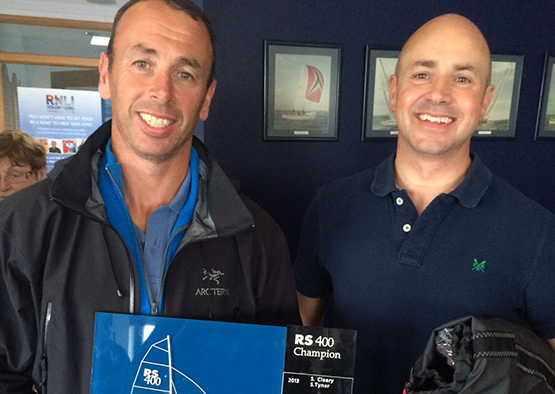
Winners Gareth Flannigan and Dave Fletcher from Ballyholme
After a very boisterous Saturday evening, which spilled into Austies pub in the next street, the locals being no doubt delighted to be serenaded by the RS400 choir in full voice, singing such classics as Eric Cantona’s “Will Grigg’s on fire”, a foggy looking fleet dragged themselves into their wet coldsuits, and drifted out onto the river to pay the penalty that they had earned the night before. As the winds topped out at a fruity 18 knots, Red Cards were handed out to Brian Holmes, Trevor Darcy, and in the last race, John Downey, with repair bills, and Liam Donnelly, Robbie O’Sullivan, Michael Ferguson, Dave Cheyne and Owen Laverty, with swimming lessons, generally at the wrong point in the race. In fact with the frequent kite trawling at the top mark (well, we haven’t raced in more than 3 knots of wind all year so far it feels, so a bit out of practice), matters were rather less professional looking than the previous day.
After a few cracks at starting under black, the viz went poor, and Robin Gray wisely declared a generalised drag race back to the slip, with kites popped and a full foam up back to the slip (needless to say all arriving at the same time, doh!) and some wave jumping in the standing waves at the river entrance.
So Gareth and Dave continue to rise, and it looks like the Nationals will be a hard battle with Alex, and plenty snapping at their heels, with in particular Dave Rose and Ian Hef finally starting to get their act together, and John Downey going ever quicker. Next is off the Inlands at Lough Ree in July.
RS400 Northerns Report from Cushendall Sailing Club
23 RS400 dinghies made it to Cushendall Sailing Club in County Antrim with many travelling the full length from Cork writes David Rose. The fleet took advantage of the new lazy boy start time of 2pm that the class has chosen, to facilitate those from further afield and avoid an extra night away from domestic bliss. Seems to have been popular, with the drifting cyclonic various wind conditions for the Saturday which could have led to 6 hours of torment, being superseded by a shorter 4 hour session of torment, leaving two hours of extra mental energy to be invested in the goings on of the Cushendall Sailing Club’s shiny new bar. We like to think they rebuilt the bar for our event, so it would have been rude not to give it a suitable work out, and all retired to bed/ the Wedding Party in the local hotel, either fearful, or ignorant, of the appalling forecast for the Sunday….
Actually, star performer with two victories on Saturday, was Robin Gray, our adopted IRO, who succeeded in getting two races in before the gas officially ran out, and the great tow back in was able to commence. A stonking BBQ and quality bar staff attitude allowed for a quick turn around and racing began again about an hour later in the new bar and the rest is a distant memory.
Alex Barry, rather as one might have expected, defied the weather gods and flew around the course at twice the speed of anyone else to score two wins himself, and sealed the deal in Sunday’s tide slide with another podium to close the deal in slow style. I think we were all glad to get back ashore before scurvy set in and we all went mad, as there really was no chance to get any meaningful competition in aside from what was achieved. Only other noteworthy performance was Brian Holmes of Portcoleraine, who nailed his first top three spot in Sunday’s race. We will be expecting great things from this young man in years to come. Also great to see the local boats out again, and hopefully we will see them back on circuit again soon.
As always when we go to visit one of our less well known destinations, the stops were all pulled out, and Cushendall’s fab team left us feeling very heavily loved and pampered, and certainly well fed. Heartfelt thanks to Marc and his merry band of volunteers, you did yourselves proud.
Next up is a trip for the first time to Sligo YC in the slightly North West, for the Westerns, in late June, where hopefully sailing will be a bit livelier. Also on the go we have some local circuitry in the North and East, with a sanctioned series of one day events, mostly regattas, to keep the local activity going strong.
RS 400s, 200s & Feva Easterns At Royal St George Yacht Club
It was a weekend of superb sailing for the RS Fleets in Dublin Bay. Having the season opener in the east at the Royal St. George Yacht Club usually brings out a great fleet and that’s what we had with 42 boats across the three RS fleets at the Championships this year writes David Rose. Full results are downloadable below as PDF files.
The RS200’s is a class that is heating up considerably this season, with lots of quality sailors already in the fleet and a real injection of fresh competitors in the dinghy park. A few boats are sporting the sharp new design see-through sails, which make the boats look great as well as giving a better view of traffic on the race course.
The standard in the RS400 fleet has yet again gone up a notch. It is now more like the racing standard at a UK nationals or Europa cup. Our Olympian and multiple Fireball national champion turn Race officer for the weekend Barry O’Neil and his team were impressed by the standard of starting. “It was like Olympic class starting, all boats finding a lane and no mid–line sag. Not much bad behaviour and if the line was not 100% square then it was always going to result in a recall.”
Many thanks go to Barry and his team, including the mark layers giving their time on a bright but cold weekend. The team had to manage large wind shifts, and did so admirably. A new format for the courses was being used for this event. The RS200’s and RS400’s were sharing the same windward leeward, rather than in previous events where the trapezoid course was used for the RS200’s. This was making it hard for the OOD to adjust the course once the 200’s were off. Barry has given feedback already to the classes, and this may result in tweaks for future events.
Michael Keogh provided results and photography at the weekend, and Michael Tyrell was race officer for the RS Feva class, running a separate course inside the harbour.
Thanks go out to club Commodore Justin McKenna and vice commodore Michael Pomeroy and the RstGYC members. The facilities at the George are superb and the fleets really enjoy sailing out of the club. The welcome was extremely friendly and there were many people giving their time both at registration and with the smaller details like helping with trolleys.
Sailing Conditions
Day one was light to medium conditions averaging about 12 knots out of the North. There was a sometimes tricky short chop, and no shortage of oscillation on top of larger shifts that hung about for longer.
Day two had similar shifty conditions, again off the land and this time out of the North West, with more exciting gusts of 20 knots plus at times.
RS400 Easterns Report
What a weekends racing for the 20 top class teams that fought it out for national level honours this weekend. It’s a testament to the quality of the field that there were five different race winners over six races. The runner up for this regatta, was to be two time National RS400 champion Alex Barry with local sailor Conor Byrne as crew this time out. The pair were denied any race win in the series but were still extremely consistent as Alex has been for the last two seasons in the class.
Alex was gracious in defeat in round one of a long season and when asked for his thoughts on the weekend he said, “This weekend was exceptionally tight racing, in a fleet full of talent”.
Day one saw the excellence of MBSC sailors John Downey and Sandy Rimmington. They put out their stall early with a superb 2, 1, 6, on a day where most people had at least one bad result. The score was only bettered by one team and by one point. Gareth Flannigan and David Fletcher (BYC) had posted a 1, 2, and 5. Robert Espey and Michael Gunning (BYC) were very well placed also carrying a 3, 11, and 1.
Looking further down the sheet, local RstGYC stars and ex national champion Emmet Ryan and James Ryan were lying ninth, and needed to post some good results. They were to open day two with considerably more form carding a bullet. They finished the regatta stronger than they started moving to sixth overall one place ahead of Corks David Rose and Ian Heffernan in seventh.
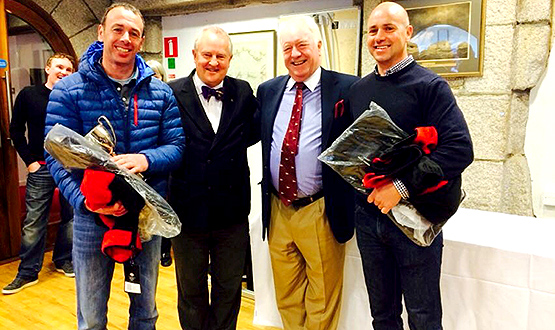
RS400 Winners (from left) Gareth Flanagan with Commodore Justin McKenna vice–Commodore Mike Pomeroy and David Fletcher
On day two it was Espey and Gunning who showed they mean business with a 3, 2 putting them slightly ahead of the two MBSC boats vying for the title, but it was not to be and after carding a tenth that they had to carry, they dropped off the podium and had to settle for fourth place. Bob said afterwards, “Once you find yourself in the pack it’s very hard to fight back”.
Flannigan and Fletcher are a class act and signed off with a second place to finish a sublime regatta and are 2016 Eastern Champions.
Alex and Byrne were second and John and Sandy took 3rd place this time out.
Chris Penny and Simon Martin had a superb regatta and finished on a high with a win in race six and fifth place overall.
So the early season honours and silverware have headed north with Flannigan and Fletcher, the other top teams will want to ensure they don’t have it all way and successfully pluck the Northern trophy from their grasp next time out.
RS Feva Report (By Elaine Malcolm)

RS Feva Winners Henry Start and Morgan Devine with their competitors
In order to encourage the newer members of the RS Feva class this year, the Eastern’s were sailed on a separate course inside Dun Laoghaire harbour. The 11 boat fleet, under the capable race officer Michael Tyrrell and his team, had 8 races over the two days.
Local RstGYC sailors Henry Start and Morgan Devine were to master the conditions and win the event. They were challenged all the way by newcomers to the class, Tim Norwood and Finn Cleary from RIYC. The pair had stolen a march, winning three of the four races in light winds on Saturday.
Third place went to Marcus O’Leary and Jeff McGovern who just edged out the all-girl crew of Emily Arrowsmith and Caira Little. Malahide brothers Liam and Aidan Donnelly carded three third places on Sunday, showing their potential going forward.
Thanks go to our coaches at the weekend Pheobe Norwood and Meg Tyrrell, who provided plenty of encouragement all weekend. Congratulations to all who competed in the RS Feva Easterns.
RS 200 Report
11 RS200s turned out for the first event of the year, the fleet was more of a “mature” crowd, with lots of couple’s combos. This is an area of huge growth in the fleet, and should marry well with the younger contingent who often miss this event due to study commitments.
One of the new faces in the RS200 was multiple fleet dinghy and keelboat champion Neil Spain, who is sailing with his wife Maeve. Another top sailor out there was Women’s match racing star Mary O’Loughlin, joined by past Irish Olympic flag bearer Ciara Peelo as crew. Unsurprisingly they proved to be very competitive. We were also really pleased to have teams up from Caullan Sailing club, which has a very strong local fleet or RS200s.

RS200 Winners Marty O’Leary and Rachel Williamson
On Saturday the fleet enjoyed 3 sharp 48 minutes races on the W/L course. Marty O’ Leary and Racehel Williamson showed their considerable pedigree. Marty was not distracted by being heavily involved in the organisation of the weekend for all classes. The pair put their stall out early and led overnight, to give themselves every chance of defending the title of which they were the holders.
It was very close from 2nd to 5th, with a point separating each team after day 1. Our former RS Fleet chairman Frank O’Rourke (GSC), sailing with college team racer Lisa Smith were the top challengers overnight.
So onto day two and the final 3 races of the championship. Sunday involved more breeze and even tighter racing as teams started to get more aggressive and accurate on the start line. O’Loughlin and Peelo seemed to think they were allowed to start before the competition, but were being a little too keen on two occasions and were duly recalled by the race management in races 4, and 5.
Craig and Cooney from the RStGYC showed some excellent pace and moved themselves up into 2nd overall going into the final race. They were not to go all the way however as the event was already signed sealed and delivered with one to go. Greystones O’Leary and Williamson had delivered another excellent performance which is the norm for this very talented pair who defend their title and remain RS200 Eastern Champions for 2016.
O’Loughlin and Peelo finally decided to start with everyone else in race six. This proved to be a very solid strategy as they have plenty of pace and lead the final race from start to finish. Frank and Lisa worked hard and managed to claw back 2nd place, leaving Craig and Cooney to take bronze a point ahead of the Spains.
See you all at the next event.
NI RS400 Autumn Series Set for Bumper Edition
Roll it back a year, with storms and millponds alternating weekly, we had completed only four races by this stage of the Autumn series. Roll forward a year and thankfully after three days racing at Royal North of Ireland Yacht Club we are already at nine races completed on Belfast Lough. If we continue like this it is set to be a 36+ race bonanza RS400 Autumn Series writes Dave Cheyne RS Ireland Chairman.
Glorious conditions have prevailed these last two Sundays, and despite a backdrop of Ireland’s sad exit from the other great sporting show in town, the RS400 sailors are in high spirits with great racing fresh in our minds. The first Sunday had been a little topsy-turvy, but that is a distant memory now, with a cracking series to remember well underway.
A few regulars forgot to turn up, presumably solstice responsible for that, though we still had 9 ships on the start line, some without clocks and compasses, which to be honest aren’t that big a help with Gerry Reid calling the last minute out followed by a 100 metre sprint for a beat.
Each race lasts about 15-20 minutes, but this is intense, and teams were wheezing and gasping as they quickly contend with all the hoists gybes and drops. The busy roundings abound and its great competition. For this type of racing all you need is a good Race Officer, a RIB, three marks, and the right attitude as a fleet. Everyone agreed that this was more fun than many of the well-attended full championships we have enjoyed all season.
So Liam Donnelly, in “Zimmer Frame” has established an early lead, Cushendall’s Paul Mclaughlin and Mick McKinley should really be second, but until the discards (could be 6 by the series end….) kick in, DrC and Stevie/Charlie sit in second, with everyone else snapping at their collective heels.
How lucky we are to be involved in this sailing, and what a great focus for the week this is.


























